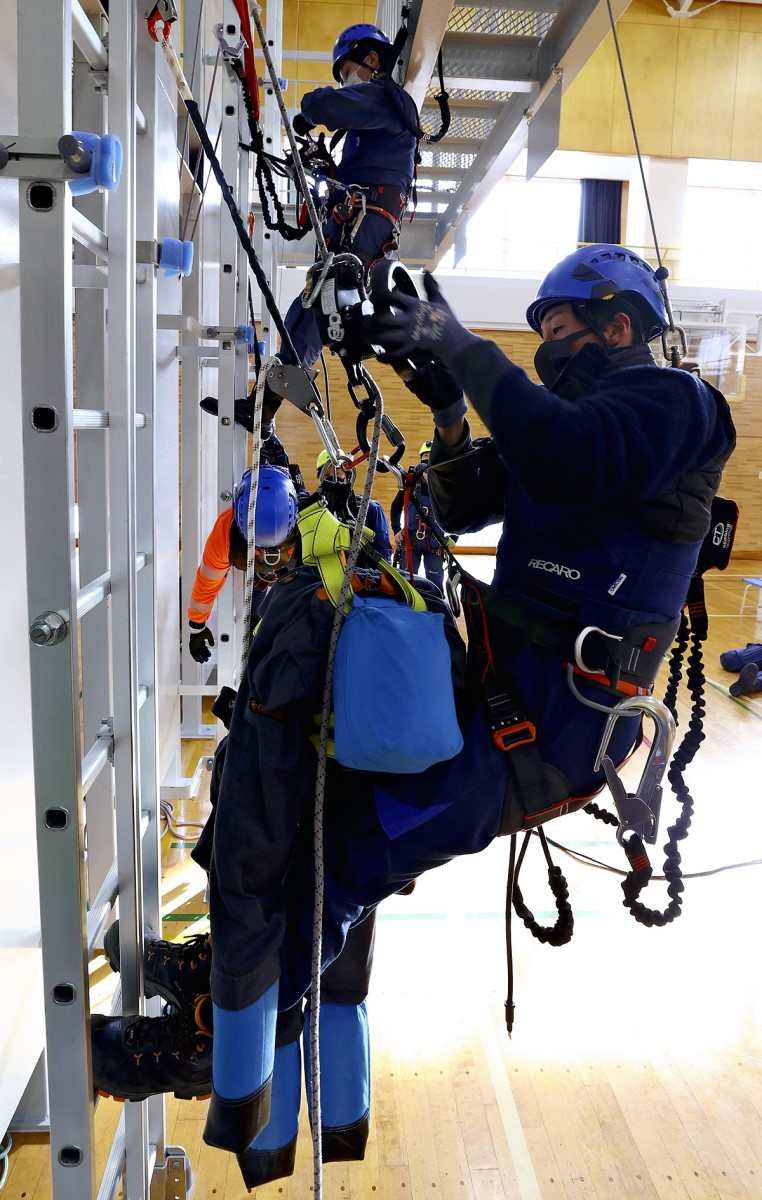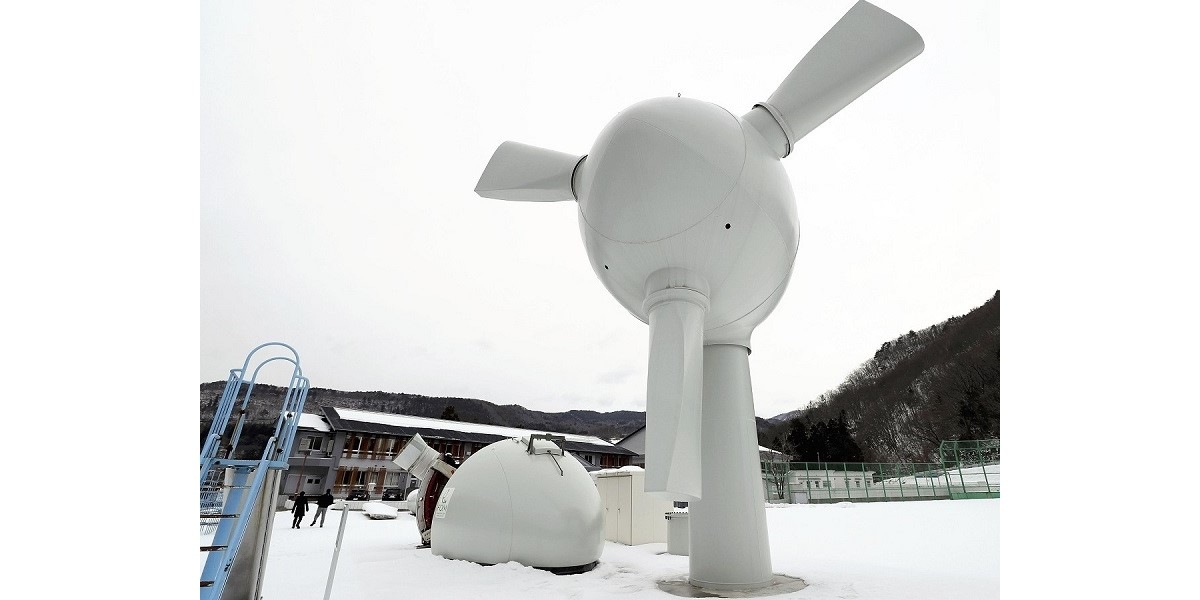
Students train at the FOM Academy in Fukushima City on Feb. 1.
12:12 JST, February 27, 2023
Japan lacks sufficient skilled personnel to maintain and inspect wind turbines. If the nation is to expand its wind power generation capabilities, staff must be recruited and trained on an urgent basis. Private training facilities are popping up at a rapid pace, but the present number of maintenance workers stands at about 20% of the number expected to be needed in the future. The national and local governments are keen to widen the use of renewable energy and are calling for measures to address the manpower shortage issue.
Shuttered school
On Feb. 1 at the FOM Academy — a training facility in Fukushima City — instructor Toshimitsu Yoshida, 53, asked the students what they would do if a colleague lost consciousness while working at high altitude. As part of a role-playing scenario, the students used a rope to lower a person feigning injury to the ground.
The academy, which opened last June and operates out of a closed elementary school, is administered by an association of local companies. The gymnasium space features a dozen 10-meter-high ladders to facilitate “high-altitude” training. The schoolyard, meanwhile, is dotted with full-size wind turbine parts.
In recent years, wind turbines have become increasingly large, with some reaching over 100 meters in height. Blades can rotate at speeds of up to 300 km/h, but their surfaces can suffer severe damage due to colliding with rain and solid particles in the air.
If left untreated, blades can break, which can lead to serious accidents. Accordingly, maintenance workers must spend long hours at high elevations to locate and repair damaged areas. Maintaining the precision equipment that controls the angle and rotation speed of turbine blades requires great expertise. “[The academy’s] facilities are better equipped than our own training facility,” said Hitachi Power Solutions Co.’s Yukihiro Shirahama, 47, who took part in the FOM training. “We can receive more practical-based training, such as how to escape in the event of a fire.”
Increasing capacity
According to the Japan Wind Power Association, as of December, there were approximately 2,600 wind turbines in Japan, with a total capacity of 4.8 million kW. With energy prices soaring due to Russia’s invasion of Ukraine, wind power generation is becoming increasingly important, and the government has set a goal of increasing output capacity five-fold to 23.6 million kW in fiscal 2030.
Toru Nagao, a specially appointed professor at Ashikaga University and a director of the Japan Wind Energy Association, said, “3,000 workers will be needed to achieve that goal.” The number of maintenance workers will also have to increase five-fold from the current 500-600. However, the environment for human resource development is not encouraging.
European and U.S. manufacturers, which produce most of the wind turbines used in Japan, require the maintenance and inspection workers to undergo training at facilities certified by the Global Wind Organisation (GWO), an international nonprofit organization headquartered in Copenhagen. However, there are only four GWO-certified facilities in Japan — including the FOM Academy — far fewer than in Europe (about 320) and China (about 20).
Expanding employment
To address this issue, the government has since last fiscal year been subsidizing universities and companies’ human resource development curricula and training facilities. Furthermore, some local governments have begun to support maintenance contractors as a way to expand local employment.
From fiscal 2019, Fukushima Prefecture has subsidized employee-training costs for companies entering the wind turbine maintenance business in the prefecture. Akita Prefecture, where commercial operation of Japan’s first large-scale offshore wind farm began last December, has established a similar system, and estimates that it will provide employment for about 16,000 people over 20 years until 2040. A prefectural official said: “No matter how much equipment you put in place, you can’t keep it running if you can’t maintain it. We hope to develop human resources and establish an industry centered on wind power generation in Akita Prefecture.”

Wind turbine parts are seen in Fukushima City.
Less than 1%
Many countries use wind power as a main source of renewable energy. In Europe, prevailing westerly winds provide stable wind directions, and shallow waters make it easy to build offshore wind power generation facilities. According to the Natural Resources and Energy Agency, wind power in 2020 accounted for 22.8% of total power generation in Germany and 24.3% in the United Kingdom. Japan’s figure was only 0.9%, trailing behind the United States (8.1%) and China (6.0%).
The government has set a goal of significantly raising the ratio of its renewable energy from the current 20% to 36-38% in fiscal 2030. The government aims to take advantage of Japan’s island-based geography to introduce 30 to 45 million kW of offshore wind power by 2040 — equivalent to 30-45 nuclear power plants — and is also considering establishing offshore wind power generation facilities within its exclusive economic zone (EEZ).
"Science & Nature" POPULAR ARTICLE
-

Genome Study Reveals Milestone in History of Cat Domestication
-

Big Leap in Quest to Get to Bottom of Climate Ice Mystery
-

Security Camera Footage Vulnerable to Outside Access; Investigation Finds 3,000 Pieces Exposed Online
-

Japan Set to Participate in EU’s R&D Framework, Aims to Boost Cooperation in Tech, Energy
-

Paws on Parade: Nairobi’s Dogs Dazzle at ‘Pawchella’
JN ACCESS RANKING
-

Tokyo Economic Security Forum to Hold Inaugural Meeting Amid Tense Global Environment
-

Keidanren Chairman Yoshinobu Tsutsui Visits Kashiwazaki-Kariwa Nuclear Power Plant; Inspects New Emergency Safety System
-

Imports of Rare Earths from China Facing Delays, May Be Caused by Deterioration of Japan-China Relations
-

University of Tokyo Professor Discusses Japanese Economic Security in Interview Ahead of Forum
-

Japan Pulls out of Vietnam Nuclear Project, Complicating Hanoi’s Power Plans


























